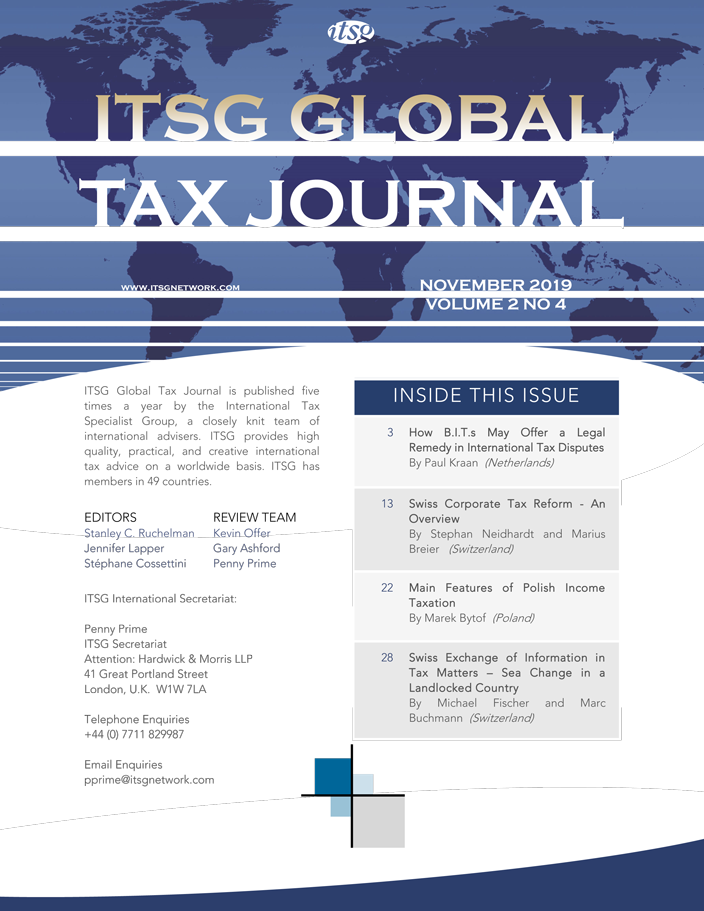SUMMARY
Traditionally, international tax disputes focus on provisions in income tax treaties, including reduction in tax on various types of investment income, increased threshold for imposing tax on business profits, and procedures to claim relief in the event of double taxation or the imposition of tax that is not in accordance with the terms of the treaty. However, income tax treaties may not be the only legal remedy available in an international tax dispute, as countries also conclude bilateral investment treaties (B.I.T.s) with the aim to protect and stimulate cross-border investment. Disputes under B.I.T.s generally are settled by an arbitration panel. This article sets out under which circumstances an international tax dispute may fall within scope of an investment treaty.
INTRODUCTION: SHORTCOMINGS IN LEGAL PROTECTION UNDER TAX TREATIES
Traditionally, bilateral income tax treaties are considered the appropriate means of redress for avoiding double taxation arising from a cross-border transaction. The allocation of taxing rights between states under such treaties is generally based on internationally accepted principles and methods. These are laid down in the model treaty (and related commentary) which is established under the auspices of the Organisation for Economic Cooperation and Development (O.E.C.D.)1 and in the United Nations (U.N.) Model Convention2.
O.E.C.D. Member States are predominantly prosperous countries with a high income per capita. However, in recent decades, the economic emergence of certain countries that are not O.E.C.D. Member States has resulted in the increased importance of investment in those countries and (economic) self-awareness, as well.
As regards foreign investment in such emerging economies, taxing rights are allocated in ways that strongly emphasize the position of the source state. This may concern source taxes in ways that are not entirely customary in international relations, such as the indirect levy of tax on capital gains (through a withholding tax that is imposed on the purchase price). Also, the interpretation of recognized international tax concepts differs in many cases from the common international standards, such as those that define a permanent establishment and explain when it may exist.
Initially, a foreign company that is confronted with such unique application of tax concepts will attempt to obtain relief by using legal remedies available in the relevant country. However, local judiciary authorities may not always be completely independent and, even when independent, may endorse the divergent views taken by the local tax administration.
In such circumstances, multinational companies may attempt to obtain relief through remedies outside the local legal system. An applicable income tax treaty may provide relief through a the mutual agreement procedure (M.A.P.) between the competent authorities of the contracting states concerned. However, the M.A.P. in most tax treaties only requires the contracting states to make an effort to resolve the issue and may not eliminate double taxation where the competent authorities maintain differing views on a particular provision of the income tax treaty. In many instances, pursuing this route does not lead to a satisfactory outcome for the taxpayer because, in part, the taxpayer is not even a party to the M.A.P. between the relevant states.
For this reason, an arbitration provision has been developed within the context of the O.E.C.D. Model Convention3 which makes it possible to proceed to compulsory binding arbitration if the competent authorities do not reach an agreement. The aim is to include binding arbitration in as many tax treaties as possible. Indeed, the Base Erosion and Profit Shifting (B.E.P.S.) Action Plan developed by the O.E.C.D. earlier this decade includes Action 14, which calls for effective dispute resolution mechanisms. Meanwhile, within the E.U. this has led to the adoption of a directive4 which offers a uniform mechanism to address tax treaty disputes among E.U. Member States in accordance with the B.E.P.S. Action 14 minimum standard. Nonetheless, there is little experience with arbitration under a bilateral income tax treaty.
However, international tax disputes are not governed solely by procedures of income tax treaties. With regard to cross-border investment, states often conclude a B.I.T. that is intended to protect those investments from improper state action in the host country. If any disputes should result, the International Centre for the Settlement of Investment Disputes (I.C.S.I.D.) of the World Bank can be requested to appoint an arbitration panel to resolve the dispute, absolutely. Such request can be made directly by the investor concerned. This article examines the extent to which international tax disputes may be resolved under the terms of a B.I.T.
INVESTMENT PROTECTION AGREEMENTS
Nature and content
The first B.I.T.5 was concluded in 1959 between Germany and Pakistan6. The current investment protection agreement network includes thousands of B.I.T.s, as well as a large number of multilateral investment protection agreements. The network of investment treaties, therefore, provides broad coverage. Often, a B.I.T. is concluded prior to consideration of an income tax treaty.
While income tax treaties are mostly based on the O.E.C.D. Model, there is no generally accepted model B.I.T. However, numerous countries have developed unique unofficial model agreements from which a B.I.T. is negotiated. These unofficial model agreements may form the basis of a multilateral agreement. As such, the legal form of investment protection agreements can differ7. Despite any differences, investment protection agreements often adopt a similar structure, pursuant to which investments are stimulated and protected by means of guarantees8.
This can be explained by the fact that the letter and spirit of every investment protection agreement is ultimately the same: the creation of a favourable investment climate by protecting and stimulating investments9. The provisions of nearly all investment protection agreements provide for the protection of investments against expropriation and unreasonable treatment, liberalization through the abolition of legal prohibitions on investment, and the creation of a level playing field in the form of equal treatment10.
In general, the letter and spirit of an investment protection agreement is realized through a number of substantive rights11.
- Expropriation is prohibited unless the expropriation is non-discriminatory and in the general interest. In that event, the affected investor is entitled to adequate compensation. (This is the most important substantive right.)
- Investments are entitled to be treated in a fair and equitable manner and to complete protection and security.
- Investors are entitled to equal treatment and the right against discrimination based on nationality. (A most-favoured-nation (M.F.N.) clause is often included.)
- Repatriation of income earned from the relevant investments cannot be prevented.
- Provisions of international law that are more favourable than the investment protection agreement are given preference over the provisions in the investment protection agreement, provided a reference to international law is part of the agreement.
- An umbrella clause may be included in the investment protection agreement12 under which the contracting states are obligated to fulfil all the undertakings given in respect of an investment. (By means of these substantive rights, contracting states can guarantee investors that their investments will be free of specified sovereign risk13.)
Legal protection
In addition to substantive rights, investment protection treaties contain procedural rights that make the realization of substantive rights possible14. The legal structure of the investment protection agreement allows the aggrieved party to enforce its rights directly by means of an arbitration panel specifically appointed for that purpose, without the need to obtain government approval in the host state. This differs considerably from the situation under income tax treaties, where disputes must generally be resolved through a M.A.P., where the taxpayer has little or no influence. Instead, an investment protection agreement allows the taxpayer to maintain control over all facets of the procedure, from commencement of the action to the hearing, itself15. This can be particularly advantageous if the host country cannot provide fair and balanced legal protection due to corruption, the absence of an independent judiciary, or stonewalling by the taxation agency16. In this way, an investment protection agreement guarantees permanent and adequate legal protection.
The investment protection agreement designates the body, or bodies, that are competent to decide investment disputes under the applicable agreement. In most cases, the body will be an arbitration panel appointed by the International Centre for Settlement of Investment Disputes (I.C.S.I.D.), which is part of the World Bank. More than 140 countries recognize the I.C.S.I.D.17. As these agreements can differ, case law under other agreements is not controlling. Nonetheless, case law provides guidance for the interpretation of agreements. Investment protection agreements have similar purposes and provide similar protection in many ways. As a result, decisions under other comparable agreements may be taken into account according to the Vienna Convention on the Law of Treaties18.
Accessibility
Three facts must exist to successfully invoke protection offered by an investment protection agreement:
- A qualifying investment is made in the territory of one of the contracting state.
- The qualifying investment is made by a qualified investor from the other contracting state.
- As to the investment and the investor, an obligation contained in the investment protection agreement purportedly has been violated.
Almost all investment treaties define the term ‘investment’19. The definition generally is broad, such as ‘every kind of asset invested in accordance with the national laws and regulations of the Contracting Party in the territory of which the investment is made’ or ‘every kind of asset’ — followed by a non-exhaustive list of qualifying investments20.
It is not surprising that the broad definition of ‘investment’ has led to broad interpretations in the case law21. Arbitration panels are prepared to give broad interpretations to the term ‘investments’ to ensure the scope of protection is extensive22.
Investor activities must be assessed on an aggregate basis. Consequently, if the activities consist of separate elements that can only be considered an investment when viewed as a whole, protection under an investment protection agreement is possible even if host country obligations to only one of those elements has been breached23.
A territorial factor must also be present for an investment to qualify for protection. The investment must relate to one of the contracting states for an investment protection agreement to be applicable. Hence, there must be a sufficient nexus with the host country. Courts have applied a relatively low threshold when determining whether nexus exists24. This is evidenced by the fact that a large number of treaties include a provision that makes the agreement applicable to investments that are made through a business resident in a third state.
Once a particular investment has been found to be covered by an investment protection agreement, the next issue is whether the holder of the investment has access to the investment protection agreement. Traditionally, the definition of ‘investor’ included in most investment protection agreements applies to natural persons, legal entities, and partnerships25. Natural persons qualify as an investor if they hold the nationality of one of the contracting states. This must be determined according to the domestic law of the investor state26. Different criteria are used to determine if a legal entity or partnership qualifies as an investor. Included are the place of incorporation and the place where control is exercised. Other criteria may be used where the facts are unique.
E.U. situations
Specifically with regard to B.I.T.s concluded by and between E.U. Member States, the Achmea case27 of the European Court of Justice (E.C.J.) found an arbitration clause in a B.I.T. to be incompatible with community law, as tribunals essentially remove disputes from the jurisdiction of the Member States’ courts and consequently from the E.U.’s judicial system. This ruling has significant consequences for arbitration clauses in B.I.T.s concluded by the Member States.
Under the E.U. treaties, the Member States’ courts and the E.C.J. collaborate in resolving disputes involving aspects of community law. Through the preliminary reference mechanism under Article 267 of the Treaty on the Functioning of the European Union (T.F.E.U.), domestic courts refer questions on community law to the E.C.J. and are required to follow the answers provided by the E.C.J. This system should ensure that community law is applied effectively and uniformly throughout the E.U. and preserves the essential characteristics of the legal order in a uniform way within the E.U. To ensure the effectiveness of community law, courts in Member States must make preliminary references to the E.C.J. To that end, community law must always prevail over other sources of law, whether international or domestic.
Taxation in investment protection agreements
General
Having outlined the general contours of a B.I.T., the next issue is whether a B.I.T. can provide protection in regard to tax measures. As previously described, in certain cases, the legal protection provided by an income tax treaty is inadequate. The additional legal protection provided under an investment protection agreement can be of great significance in these circumstances.
In most countries, autonomous tax policy is a sensitive subject. This finds expression in B.I.T.s. In general, states are wary of third-party actions that may impose undesired limitations on taxation. This concern extends to B.I.T.s28 and often is manifested in a number of B.I.T.s through the inclusion of a carve-out provision. The carve-out removes taxation from the scope of the B.I.T. However, other B.I.T.s include only a partial exclusion for taxation29. The protocol to the Germany-Mexico B.I.T. states that tax measures that violate provisions of a B.I.T. can be subject to arbitration, with the exception of those provisions relating to national or M.F.N. treatment30.
Taxation as a form of indirect expropriation under B.I.T.s
The right of a state to impose tax is a fundamental attribute of sovereignty. Consequently, international law provides that taxation constitutes an important exception to the rule that expropriation is not allowed without adequate compensation. By its nature, taxation involves the taking of the taxpayer's money, resulting in a form of expropriation. Nonetheless, tax exclusion clauses in B.I.T.s generally prevent effective actions against the state imposing tax.
Nonetheless, international law recognizes that taxation by sovereign states can amount to indirect expropriation in specific circumstances. In the case of Yukos31, the court ruled that the tax measures imposed by the host state on a resident of the investor state could amount to expropriation for purposes of the relevant investment protection treaty ‘if the ostensible collection of taxes is determined to be part of a set of measures designed to effect a dispossession outside the normative constraints and practices of the taxing authorities’.
The definition of ‘expropriation’ in investment protection agreements usually follows the definition found under international law32. Expropriation33 can occur both directly and indirectly34. Direct expropriation occurs if the investment is nationalised or otherwise directly confiscated by means of a legal transfer of ownership or a direct physical takeover35. Indirect expropriation occurs when a state interferes in the use of an investment or in the benefits received from that investment, even if the investment has not been physically seized and the legal ownership has not been affected. A governmental measure can also qualify as indirect expropriation if the investment’s market value decreased as a result thereof36 or if the economic benefit that could reasonably be expected was denied37. The effect of such government action is equal to that of expropriation. In broad terms, direct expropriations are rarely found, while indirect expropriations are more common38.
Taxation39 represents a partial breach of property rights. As such, most forms of taxation could be contested by invoking an investment protection agreement, although this could not reasonably be expected to be the intention of such an agreement40. As a general rule, taxation does not qualify as expropriation under international law41. Under international law, a state cannot be held liable for loss of ownership as a result of a bona fide tax that is generally accepted as a legal expression of the executive power of a government42.
Exceptional circumstances
This does not mean that taxation cannot fall under the scope of the definition of expropriation. In certain circumstances, taxation can constitute expropriation under international law43 as a result of which a tax dispute between a tax authority and an investor can be resolved by arbitration44. In Link Trading v. Moldova (2002), the arbitration panel ruled that taxation can be considered an expropriation if the nature of the tax involves ‘abusive taking’.
According to the panel, a tax is considered ‘abusive taking’ if it is unreasonable, arbitrary, discriminatory, or contrary to existing agreements45. In Encana v. Ecuador (2006), where a refusal to refund Ecuadorian V.A.T. was in dispute, the panel concluded that taxation falls under the scope of the definition of expropriation if it can be qualified as ‘extraordinary, punitive in amount or arbitrary in its incidence’46.
As a result of the current paucity of case law in regard to tax disputes, it can be concluded that two types of taxation can be identified under an investment protection agreement. Taxation that results in an indirect expropriation must be distinguished from taxation that, while having a substantial negative impact on the market value of the investment, nevertheless must be regarded as legitimate and, therefore, does not qualify as an indirect expropriation under an investment protection agreement47.
Assessment framework
Certain elements can be extracted from case law and the literature that, taken together, can create an assessment framework for distinguishing bona fide tax measures from taxation that qualifies as expropriation:
- The government measures must lead to a substantial decrease in value.
- The decrease in value interferes with the reasonable expectations underlying the investment.
- The government measure deviates from internationally accepted norms (characteristics test)48.
This assessment framework was confirmed in Archer Daniels Midland v. Mexico (2008), where the panel ruled that factors beyond a substantial decrease in value or paralyzing government interference could be taken into account in determining whether the tax constituted an expropriation:
…including whether the measure was proportionate or necessary for a legitimate purpose; whether it discriminated in law or in practice; whether it was not adopted in accordance with due process of law; or whether it interfered with the investor’s legitimate expectations when the investment was made49.
In the Revere Brass and Copper (1978) case50, the arbitration panel ruled that mining tax and royalties, imposed in violation of a concluded advance tax ruling, qualified as expropriation. The ruling formed part of a concession given to a subsidiary for the extraction of bauxite in Jamaica. The newly elected government ignored the ruling and increased the tax burden by introducing a new mining tax. Revere considered the negative impact on profitability excessive and ended its subsidiary’s activities. The arbitration panel recognized that Revere’s subsidiary still had full ownership and could have continued with its activities but regarded the matter as an expropriation under international law nonetheless because Revere could no longer make an economically effective use of the business. The profitability of the investment was severely impaired by the tax.
Substantial financial damages
While it is difficult to determine the scope and extent of damage arising from a tax measure for it to qualify as expropriation, general agreement exists that the bar is set very high51. The United Nations Conference on Trade and Development (U.N.C.T.A.D.) concluded that the damage must include ‘a significant depreciation’ in value52. Moreover, if a measure is extremely discriminatory or absurd, the extent of financial damage need not be the same as for a more common measure53. In Occidental v. Ecuador (2004)54 the panel dealt with a refusal by the Ecuadorian tax authorities to refund V.A.T., contrary to earlier agreements with the taxpayer. The taxpayer invoked the expropriation clause of the relevant B.I.T. According to the panel, the refusal did not qualify as expropriation since it did not deprive the taxpayer of the economic benefits that were reasonably to be expected or inflict substantial damages on the investment. The right to a V.A.T. refund was not a substantial part of the investment55. The previously cited Archer Daniels case is one of the few rulings that attempt to define the standard to be applied when measuring damages. The panel concluded that the damage criterion is met if the taxpayer is deprived of all or the majority of the benefits generated by the investment. Not only must the scope of the tax relevant but also the duration of the tax. A permanent loss of value will carry more weight than a temporary loss of value56.
Other provisions providing legal protection against tax measures
Equal, national treatment under non-discriminatory provisions
The Archer Daniels case previously discussed involved a 20% tax imposed by Mexico on soft drinks containing a corn syrup sweetener. The tax did not apply to soft drinks sweetened with sugar cane. The reason for this measure appeared to have been the protection of the Mexican sugar cane market. ADM was a U.S. manufacturer of corn syrup. It saw a sharp decline in the value of its Mexican investments as a result of the measure. ADM challenged the tax under the North American Free Trade Agreement (N.A.F.T.A.), a multilateral investment protection agreement. One of the grounds for its complaint was that the tax qualified as expropriation57.
The arbitration panel applied the assessment framework described above and concluded that the impact of the tax on ADM’s investments was not sufficient to constitute expropriation. However, the arbitration panel considered the tax a violation of N.A.F.T.A. because the non-discrimination provision guarantees the domestic and equal treatment of foreign investments. The arbitration panel ruled that the effect of the tax was such that U.S. manufacturers and distributors of corn syrup in Mexico received less favourable treatment than Mexican manufacturers of sugar cane. As a result, the tax violated the investment protection agreement.
Fair and equitable treatment
The Occidental v. Ecuador case58, in respect of which a decision was given under the U.S.-Ecuador B.I.T. (1993) is similar to the Archer Daniels case. Initially, the arbitration panel rejected a claim based on the expropriation provision, because revoking a right to a V.A.T. refund did not qualify as expropriation. However, after further consideration, the revocation of the refund was considered to be an unauthorized violation of the investment protection agreement. The arbitration panel considered that the right to fair and equitable treatment59 had been violated. The right to a V.A.T. refund was part of an agreement with the Ecuadorian tax authorities, which interpreted national legislation (the ruling). The arbitration panel emphasized that a contracting state to a B.I.T. must provide investors from the other contracting state with a stable and predictable legal infrastructure. That obligation is a consequence of the right to fair and equitable treatment that is mandated by the B.I.T. Whether the contracting state acted in bad faith was irrelevant. Based on the underlying facts, the panel concluded that the domestic V.A.T. legislation and the subsequent interpretation in a tax ruling materially contributed to Occidental’s decision to invest in Ecuador. The panel concluded that ‘the tax law was changed without providing any clarity about its meaning and extent, and the practice and regulations were also inconsistent with such changes’60. As such, the panel ruled that Ecuador failed in its obligation to provide a stable and predictable legal system. The revoked refund resulted in a violation of the existing B.I.T.61.
CONCLUSIONS
The scope of substantive rights laid down in an investment protection agreement in the context of taxation is difficult to define, partly due to the scarcity of guidance in the case law. Nonetheless, it follows from the above that a B.I.T. can provide legal protection against those forms of taxation that may constitute a violation of its provisions. Particularly, the provisions on expropriation, non-discrimination and the right to fair and equitable treatment set limits on a contracting state’s right to impose taxation.
Where taxation results in a substantial decrease of the value of an investment, it may be a form of expropriation that can be redressed under a B.I.T. if it detrimentally affects the reasonable expectations of the investor that formed the basis for its investment. However, access to a B.I.T. is allowed only if the imposition of the tax deviates from internationally accepted legal standards. The most obvious example of an internationally accepted legal standard is a tax that violates the principle of non-discrimination. The tendency of arbitration panel decisions is that when the violation of a generally accepted legal principles is flagrant, the disputed government action on the investment need not be as great in order for a claim by an affected investor to be upheld.
Future cases and arbitration guidance will be required to determine the circumstances in which a violation of specific international tax principles can be considered a deviation from internationally accepted legal standards. In matters relating to taxation, it may be expected that an arbitration panel will apply a high standard before a claim will be upheld under a B.I.T. regarding the imposition of tax. The unanticipated imposition of tax by the host country must have a significant impact on the value of the investment and must be at odds with the reasonable expectations of the investor at the time the investment was made. If both these conditions are met, it is conceivable that a panel may conclude that such taxation qualifies as indirect expropriation.
For tax advisers who customarily look for relief under the terms of an income tax treaty, the most interesting aspect of arbitration under a B.I.T. is that the investor is a direct party to the arbitration. Indeed, the investor can instigate arbitration proceedings in addition to participating in the proceedings. The generous legal protection offered by an investment protection agreement stands in stark contrast to arbitration under a tax treaty, but it is still in the formative stages.
Arbitration under a tax treaty or an investment protection agreement does not necessarily have to be mutually exclusive. The competent authority in the state of residence can be requested to start a M.A.P. under the relevant tax treaty, while at the same time commencing proceedings under the existing investment protection agreement. Note that access to a B.I.T. may require that all avenues for domestic legal recourse have been exhausted previously. In this respect, the spectre of arbitration under an investment protection agreement can keep pressure on the mutual consultation procedure under the tax treaty.
1 O.E.C.D. Income and Capital Model Convention and Commentary, Paris, 21 November 2017.
2 U.N. Model Double Taxation Convention Between Developed and Developing Countries, U.N., as updated on 19 May 2017. This model treaty distinguishes itself from the O.E.C.D. Model Treaty by a stronger emphasis on the position of the source state.
3 See article 25, fifth paragraph, of the O.E.C.D. Model Convention.
4 E.U. Council Directive on Tax Dispute Resolution Mechanisms in the European Union on 10 October 2017.
5 In the following, the term ‘investment protection agreement’ refers to a B.I.T. and a multilateral investment agreement offering similar investment protection.
6 J.W. Salacuse, BIT by BIT: The Growth of Bilateral Investment Treaties and Their Impact on Foreign Investment in Developing Countries, 24 Int’l L. pp. 655-675 (1990).
7 E.g., A. Newcombe & L. Paradell, Law and Practice of Investment Treaties (Kluwer Law International 2009).
8 I.d.
9 See S. Franck, Foreign Direct Investment, Investment Treaty Arbitration, and the Rule of Law, McGeorge Global Bus. and Dev. L. Journal 19, p. 337 (2007).
10 K.J. Vandevelde, Bilateral Investment Treaties: History, Policy, and Interpretation (Oxford University Press 2010).
11 See S. Franck, The Legitimacy Crisis in Investment Treaty Arbitration: Privatizing Public International Law through Inconsistent Decisions, 73 Fordham L. Rev. 4, pp. 152-165 (March 2005).
12 R. Dolzer & M. Stevens, Bilateral Investment Treaties, pp. 81-82 (Kluwer Law International 1995).
13 See also Franck, supra n. 12.
14 Franck, supra n. 12.
15 H.L. Buxbaum, The Private Attorney General in a Global Age: Public Interests in Private International Antitrust Litigation, 26 Yale Intl. L. J. pp. 219-263 (2001).
16 See also Vandevelde, supra n. 11.
17 Franck, supra n. 10.
18 Vienna Convention on the Law of Treaties (23 May 1969), Treaties IBFD. See Franck, supra n. 12.
19 Dolzer & Stevens, supra n. 13, p. 26.
20 Dolzer & Stevens, supra n. 13, p. 27.
21 AR: I.C.S.I.D., 14 January 2004, Case No. ARB/01/3, Enron v. Argentina, par. 44, and Vandevelde, supra n. 11, p. 13.
22 M. Sornarajah, The International Law on Foreign Investment, p. 9 (Cambridge University Press 2004).
23 EC: I.C.S.I.D., 18 August 2008, Case No. ARB/04/19, Duke Energy v. Ecuador.
24 E.g., in AL: I.C.S.I.D., 26 April 1999, Case No ARB/94/2, Tradex Hellas v. Albania and CZ: U.N.C.I.T.R.A.L., 14 March 2003, IIC 62 (2003), CME v. Czech Republic, the court stated that ‘[it is not required that] the assets or funds be imported from abroad or specifically from [territorality of the other contracting state] or have been contributed by the investor itself’. See also Vandevelde, supra n. 11, p. 148.
25 United Nations Conference on Trade and Development (U.N.C.T.A.D.), Bilateral investment treaties 1995-2006: Trends in investment rule making, p. 12 (U.N. 2007).
26 Id., p. 13.
27 Case 284/16 Slovak Republic v. Achmea.
28 U.N.C.T.A.D., supra n. 29, p. 81.
29 U.N.C.T.A.D., supra n. 29 p. 82.
30 U.N.C.T.A.D., supra n. 29, p. 83.
31 Quasar de Valores et al v The Russian Federation, Award dated 20 July 2012.
32 A.F. Rodriguez, International Arbitration Claims against Domestic Tax Measures Deemed Expropriatory or Unfair and Inequitable, Inter-American Development Bank, Occasional Paper-SITI-11, p. 7 (January 2006).
33 Weston considers ‘expropriation’ to be ambiguous and unsuitable. He proposes using ‘wealth deprivation’. See B. Weston, ‘Constructive taking’ under International Law: A Modest Foray into the Problem of ‘Creeping Expropriation’, Virginia Journal of Intl. L. 16, pp.103-175 (1975).
34 E.g., U.N.C.T.A.D., supra n. 29, p. 44, and O.E.C.D., Working Papers on International Investment, No. 2004/4, Indirect Expropriation and The Right to Regulate, in International Investment Law p. 3 (O.E.C.D. 2004).
35 O.E.C.D., supra n. 39, p. 3.
36 MX: I.C.S.I.D., 21 November 2007, Case No. ARB(AF)/04/05, Archer Daniels Midland v. Mexico.
37 MX: I.C.S.I.D., 30 August 2000, Case No. ARB(AF)/97/1, Metalclad Corporation v. Mexico.
38 C.H. Schreuer, Part 1 — Report: The concept of expropriation under the ECT and under investment protection treaties, Investment Arbitration and the Energy Charter Treaty, pp. 108-159 (C. Ribeiro ed., 2006); 2 Transnat’l Dispute Mgmt. 3, p. 108 (June 2005).
39 For practical reasons, the definition of ‘tax’ as applied in investment treaties, is not discussed. In general, it is accepted that a tax measure will include legal provisions, procedures and their legal implementation.
40 E.g., T. Walde & A. Kolo, Investor-State Disputes: The Interface Between Treaty-Based International Investment Protection and Fiscal Sovereignty, 35 Intertax 8/9, pp. 440-447 (2007).
41 E.g., in MX: U.N.C.I.T.R.A.L., 3 February 2006, LCIA Case No. UN3481, EnCana v. Ecuador, the court stated that, ‘a tax law is not a taking of property; if it were, a universal state prerogative would be denied by a guarantee against expropriation, which cannot be the case’. In MX: I.C.S.I.D., 16 December 2002, Case No. ARB(AF)/99/1), Feldman v. Mexico, 7 I.C.S.I.D. Reports 318 (2003) 42 ILM 625, the tribunal argued that, ‘governments must be free to act in the broader public interest through protection of the environment, new or modified tax regime, the granting or withdrawal of government subsidies, reductions or increases in tariff levels, imposition of zoning restrictions and the like.’
42 Sec. 712, Restatement of the Law Third, the Foreign Relations of the U.S.A. (American Law Institute 1987); Feldman, para. 105. See also A. Kolo, Tax ‘Veto’ as a Special Jurisdictional and Substantive Issue in Investor-State Arbitration: Need for Reassessment?, Symposium, 2009.
43 Rodriguez, supra n. 37, p. 8. See also U.K.: London Court of International Court of Arbitration, 1 July 2004, Administered Case No. UN 3467, Occidental v. Ecuador. See also L. B. Sohn & R.R. Baxter, Draft Convention on the International Responsibility of States for Injuries to Aliens, 55 A.J.I.L. 545, art. 10(5) (1961) (herein, the Harvard Draft):
An uncompensated taking of property of an alien or a deprivation of the use or enjoyment of property of an alien which results…from the action of the competent authorities of the State in the maintenance of public order, health, or morality…shall not be considered wrongful, provided…it is not a clear and discriminatory violation of the law of the State concerned,…[and] it is not an unreasonable departure from the principles of justice recognized by the principal legal systems of the world.
44 Rodriguez, supra n. 37, p. 13; see also CA: N.A.F.T.A./U.N.C.I.T.R.A.L., 26 June 2000, Pope & Talbot Inc. v. the Government of Canada, Interim Award in which the tribunal concluded that, ‘a blanket exception for regulatory measures would create a gaping loophole in international protections against expropriation.’
45 MD: U.N.C.I.T.R.A.L., 18 April 2002, Link v. Moldova, available at http://italaw.com/documents/Link-Trading-Moldova.pdf.
46 MX: U.N.C.I.T.R.A.L., 3 February 2006, LCIA Case No. UN3481, EnCana v. Ecuador.
47 Wälde & Kolo, supra n. 45; R.E. Walck, Tax and currency issues in international arbitration, 3 World Arb. & Med. Rev. 2, p. 176 (2009).
48 E.g., Archer Daniels; Wälde & Kolo, supra n. 45, Harvard Draft Convention, supra n. 66 O.E.C.D., supra n. 39; Restatement, supra, n. 47, §712, cmt. (g); Iran-US.. Claims tribunal, 29 December 1989, Award No. 460-880-2, Too v. Greater Modesto Insurance Assocs., et al.; and R. Moloo & J. Jacinto, Environmental and Health Regulation: Assessing Liability Under B.I.T.s, 29 Berkeley J. of Intl. L. 2, pp. 1-66 (2011).
49 Archer Daniels, par. 250.
50 24 August 1970, Revere Copper and Brass Inc and Overseas Private Investment Corporation (1978), 56 ILR 258, discussed by M. Hunter & A.C. Sinclair, Ammoil Revisited Reflections on a Story of Changing Circumstances, in Investment Law And Arbitration: Leading Cases From The ICSID, NAFTA, Bilateral Treaties and Customary International Law p. 360 (T. Weiler ed., Cameron May 2005).
51 E.g., Kolo, supra n. 47; Archer Daniels; Rodriguez, supra n. 37; and Feldman, para 103.
52 U.N.C.T.A.D., Series on Issues in International Investment Agreements: Taking of Property 4 (2000). See also R. Higgins, The Taking of Property by the State: Recent Developments in International Law, 176 Recueil des Cours, pp. 259-324 (1982).
53 Wälde & Kolo, supra n. 45.
54 Occidental v. Ecuador.
55 Occidental v. Ecuador. See also I.C.S.I.D., 13 September. 2006, Case No. ARB/04/15, Pope & Talbot and Telenor v. Hungary.
56 Archer Daniels, para. 240:
The test on which other Tribunals and doctrine have agreed – and on which the ‘Claimants’ rely – is the ‘effects test’. Judicial practice indicates that the severity of the economic impact is the decisive criterion in deciding whether an indirect expropriation or a measure tantamount to expropriation has taken place. An expropriation occurs if the interference is substantial and deprives the investor of all or most of the benefits of the investment. There is a broad consensus in academic writings that the intensity and duration of the economic deprivation is the crucial factor in identifying an indirect expropriation or equivalent measure.
57 ADM invoked article 1102 of the N.A.F.T.A.
58 Occidental v. Ecuador.
59 Art. II(3)(a) of the Treaty between the United States of America and the Republic of Ecuador Concerning the Encouragement and Reciprocal Protection of Investment, with Protocol and a Related Exchange of Letters (27 August 1993): ‘Investment shall at all times be accorded fair and equitable treatment, shall enjoy full protection and security and shall in no case be accorded treatment less than that required by international law’.
60 Occidental v. Ecuador, para 184.
61 It should be noted that the tribunal in EnCana v. Ecuador, para. 173 considered that a contractual obligation was indeed more important than an obligation derived from general legislation and, therefore, applied to the underlying issue a more limited interpretation of the right to fair and equitable treatment: ‘[i]n the absence of a special commitment from the host state, the foreign investor has neither the right nor any legitimate expectation that the tax regime will not change, perhaps to its disadvantage, during the period of the investment’.

 Login
Login





















































